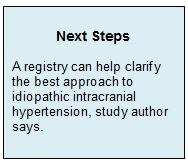Key Points:
- Researchers examine factors linked to hemodynamic failure after dural sinus stenting for idiopathic intracranial hypertension
- Extrinsic stenosis more difficult to treat, possibly requiring extensive stenting

David A Kumpe, MD, of the University of Colorado Anschutz Medical Campus (Aurora, CO), and colleagues reviewed the available data on 39 patients treated with dural sinus stenting for idiopathic intracranial hypertension over a 17-year period.
The most problematic clinical manifestations of idiopathic intracranial hypertension, explained Dr. Kumpe to NVX in a telephone interview, are headache (often severe and debilitating) as well as papilloedema, which left unchecked can lead to vision disturbance and even blindness.
Weight loss and medical therapy can often relieve the intracranial pressure, he said, but the process is slow and patients at high risk for imminent damage to the optic nerve cannot wait. Standard surgical options include both shunting and optic sheath fenestration, but both have significant disadvantages. In particular, neither are consistently effective at relieving headache, and both are typically temporary solutions to the pressure buildup that require multiple revisions.
Dr. Kumpe and his team have been working with stents to relieve intracranial hypertension for more than a decade, with a focus on relieving the stenosis seen at the transverse sigmoid junction of the dural sinus that typically occurs with this condition. The challenge is that new stenosis often appears above the placement of the stent due to extrinsic pressure (development of intrinsic stenosis from intimal hyperplasia does not appear to be a common problem).
The goals of this study, he said, were twofold: identify which patients were likely to continue to have problems following stenting and determine how best to manage these patients.
Angiographic and hemodynamic data at 1-99 months (mean 27.6, median 19.5 months) were available for 32 patients. Hemodynamic success was initially achieved in all patients, with a reduction in pressure gradient from 10-43 mm Hg to 0-7 mm Hg. At follow-up, 10 of the 32 patients experienced hemodynamic failure, with recurrence of a pressure gradient > 10 mm Hg and redevelopment of papilledema in 5. Eight of these 10 patients underwent 12 repeat stenting procedures, including extended stenting into the superior sagittal sinus; these were successful in 11 out of the 12 procedures, with a decrease in pressure gradient to < 10 mm Hg and resolution of papilledema.
Factors associated with hemodynamic failure were older age, high lumbar puncture opening pressure, female sex, and exclusively extrinsic stenosis on the stented side (table 1).
Table 1. Factors Associated With Hemodynamic Failure
|
|
Success (n = 22) |
Failure (n = 10) |
P Value |
|
Mean Age |
39.4 |
29.7 |
.0361 |
|
Mean Lumbar Puncture Opening Pressure (cm H2O) |
37.3 |
45.8 |
.0220 |
|
Female Sex |
13 |
10 |
.0030 |
|
Type of Stenosis on Stented Side |
|||
|
Extrinsic Stenosis |
2 |
7 |
.0002 |
|
Intrinsic Stenosis |
13 |
0 |
|
|
Both Extrinsic and Intrinsic Stenosis |
7 |
3 |
|
According to Dr. Kumpe, among the 3 patients with intrinsic stenosis in whom stenting failed, the failure was due to technical error. That leaves the presence of exlusively extrinsic stenosis as a key factor predicting risk of failure of the treatment, which unfortunately, he pointed out, represents the majority of typical cases.
Just Keep Stenting
Dr. Kumpe believes the key to long-term relief of intracranial pressure among patients with extrinsic stenosis is to stent as far as is needed to maintain normal pressure. “It looks like if you keep the pressure in the superior sagittal sinus normal, then the intracranial pressure stays normal,” he said, explaining that this is because the cerebrospinal fluid (CSF) is absorbed passively into the venous system. “So, by definition, the CSF pressure has to be higher than the pressure in the vein, and it looks like the key to that may be the superior sagittal sinus.”
Currently, there is no known way to predict how far up the superior sagittal sinus one must stent to achieve a durable relief of pressure, as it varies from patient to patient. Very few people are using this technique, so data are scarce.
Over the years, Dr. Kumpe has stented the dural sinus extensively. In 1 patient, he stented progressively throughout her sagittal sinus in order to eliminate continuously recurring extrinsic stenosis. “Her sagittal sinus system is stented its full length and then down and out the transverse sinus and down into the sigmoid sinus. And lo and behold that worked,” he said. “I don’t know for sure that it works [in all patients]. It seems to be working in our patients. It needs a lot more experience.”
When stenting is successful at relieving the pressure gradient, papilloedema also resolves, but the effect on headaches remains variable. Headaches associated with idiopathic intracranial hypertension are multifactorial, said Dr. Kumpe, so a single therapy is often not enough to relieve them completely.
Other interventionalists who treat this condition are calling for a clinical trial to determine the most effective approach, but Dr. Kumpe remains skeptical. He is concerned that common errors such as inappropriate patient selection may skew the results. In addition, he explained, “the problem with a randomized trial is you’re taking a cutting-edge treatment that is in the process of evolving and running that against a well-established treatment that may not have changed in 20 or 30 years. If the knowledge evolves, you can get stuck with the way you set up the trial. I think at this time a registry might be a better way to learn about this.”
Source:
Kumpe DA, Seinfeld J, Huang X, et al. Dural sinus stenting for idiopathic intracranial hypertension: factors associated with hemodynamic failure and management with extended stenting. J NeuroInterv Surg. 2016;Epub ahead of print.
Disclosures:
Dr. Kumpe reports no relevant conflicts of interest.

